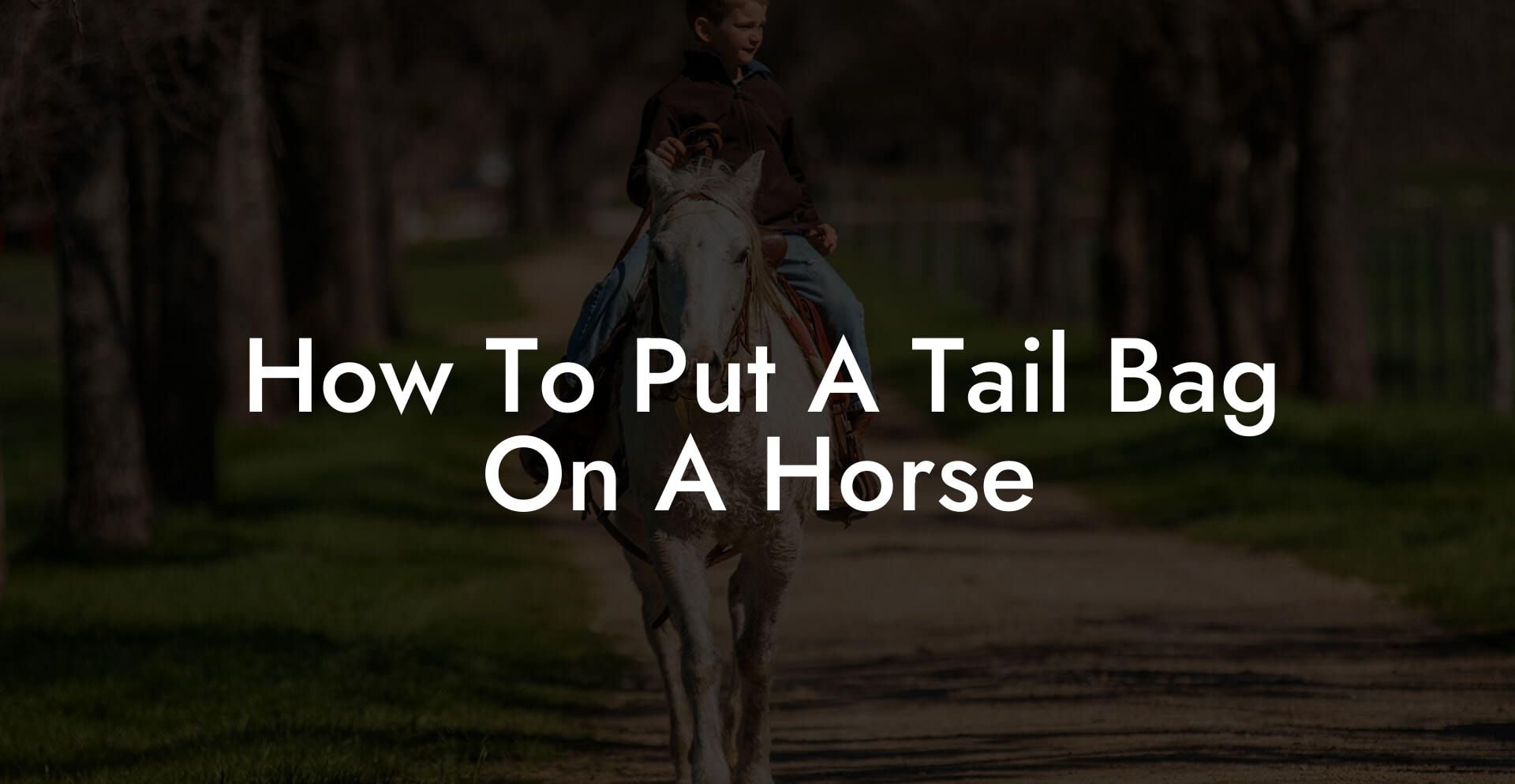Ever wondered how a horse’s tail can transform from a wild, free-flowing mane into a sleek, stylish accessory that screams equestrian chic? Strap in (or rather, bag on) as we dive into the surprisingly captivating world of putting a tail bag on a horse, a process that’s equal parts practical horse care and DIY flair. Whether you’re a Gen-Z equine enthusiast or a millennial riding the wave of modern equestrian trends, this guide is here to help you master the art of tail bagging while having a little fun along the way.
Quick Links to Useful Sections
- Understanding the Purpose of a Tail Bag
- The Essential Tools and Materials
- Step-by-Step Guide: How To Put A Tail Bag On A Horse
- Step 1: Prepare Your Horse for Grooming
- Step 2: Clean and Inspect the Tail Bag
- Step 3: Position the Tail Bag Correctly
- Step 4: Secure the Tail Bag with Straps or Fasteners
- Step 5: Final Adjustments and Comfort Check
- Tips & Tricks for a Successful Tail Bag Application
- 1. Practice Patience
- 2. Make it a Routine
- 3. Use a Mirror
- 4. Adjust to Your Horse’s Preferences
- 5. Invest in Quality Materials
- 6. Keep a Spare on Hand
- Maintaining and Cleaning Your Horse’s Tail Bag
- Common Pitfalls and How to Avoid Them
- Pitfall 1: Incorrect Sizing
- Pitfall 2: Rushed Application
- Pitfall 3: Overlooking Cleanup
- Pitfall 4: Ignoring Your Horse’s Cues
- Pitfall 5: Using Low-Quality Materials
- DIY Customizations: Making Your Tail Bag Uniquely Yours
- Resources and Community Support: Your Next Steps
- The Art and Science of Tail Bag Application: A Deeper Dive
- Integrating Modern Technology into Equine Grooming
- Expert Opinions: What the Pros Say About Tail Bags
- Tail Bag Maintenance: A Long-Term Commitment to Comfort
- FAQs: Your Top Questions on Putting a Tail Bag on a Horse Answered
- Your Journey to a Flawlessly Bagged Tail
Understanding the Purpose of a Tail Bag
Horse grooming has evolved beyond the basics of brushing, bathing, and tack care. Today’s equestrians are all about style, comfort, and innovative solutions that enhance a horse’s natural beauty. One such innovation is the tail bag, a specialized accessory designed to keep a horse’s tail neat, protect it from dirt and debris, and even help with the oft-overlooked issue of tangling or snagging during rides.
At its core, a tail bag functions much like a fashion statement fused with functionality. It offers superior comfort by shielding the tail from harsh weather conditions while reducing friction against the saddle or busy arena surfaces. Moreover, for horses sporting long, luxurious tails, the tail bag can serve as a grooming aid, minimizing the need for constant detangling and making the overall tail care routine smoother.
The secret is in the details: a well-installed tail bag accentuates your horse’s appearance, boosts confidence during competitions, and even reduces the chance of injury from accidental snags. And let’s face it, a neat tail never goes out of style.
The Essential Tools and Materials
Before diving headfirst into our step-by-step tail bag application tutorial, let’s get acquainted with your new best friends in the stable. Having everything laid out and ready will not only streamline the process but also prevent any “oops” moments when your horse is already fidgeting impatiently!
- Tail Bag: Choose one that fits your horse’s tail length and thickness. Options vary from leather to sturdy fabric, each with its own style and benefits.
- Adjustable Straps or Fasteners: Essential for ensuring the bag stays securely in place without causing discomfort.
- Comb or Tail Brush: A thorough grooming session goes a long way before bagging.
- Cleaning Supplies: Mild soap, water, and lint-free cloths for cleaning both the tail and the bag if needed.
- Scissors or Shears: For trimming any tangled or matted hair that might interfere with a smooth installation.
- Optional: A conditioner spray to detangle and soften the tail hair, making it easier to slide into the bag.
With these supplies at hand, you’re not just equipped, you’re empowered to pamper your four-legged friend and give its tail the spotlight it deserves.
Step-by-Step Guide: How To Put A Tail Bag On A Horse
Let’s roll up our sleeves (or in this case, secure the straps) and explore the detailed process of applying a tail bag. This guide is broken down into manageable, easy-to-follow steps that ensure both you and your horse remain happy throughout the procedure.
Step 1: Prepare Your Horse for Grooming
First things first: create a calm and pleasant atmosphere for your horse. Most horses appreciate a little extra attention before any grooming session. Begin by:
- Securing the horse in a safe, familiar environment.
- Giving your horse a gentle pat or some soothing words to ease any anxiety.
- A thorough grooming session with a brush or comb to remove dirt, loose hair, and tangles from the tail.
This initial preparation not only cleans the tail but also helps in identifying areas that might need extra attention. Think of it as setting the stage for a fashion show where your star, your horse, is about to dazzle!
Step 2: Clean and Inspect the Tail Bag
Before you introduce the tail bag to your horse’s tail, ensure that the bag itself is clean and in pristine condition. Dirty or damaged bags can not only reduce the aesthetic appeal but also potentially irritate your horse’s skin.
To do this:
- Wipe down the bag with a damp cloth using a mild cleaning solution if it’s fabric-based, or a leather conditioner if it’s made of leather.
- Inspect the straps, fasteners, and overall fabric integrity.
- Make sure there are no loose threads or rough edges that could snag or irritate the tail hair.
A clean bag not only looks better but promotes better hygiene, an important consideration for any caring horse owner.
Step 3: Position the Tail Bag Correctly
Now comes the fun part, positioning the tail bag. Gently hold the tail and slide the bag on, ensuring it covers the desired length. Most tail bags are designed to sit snugly against the base of the tail, but the exact position may vary depending on the style and your horse’s specific hair texture.
Keep these key points in mind:
- Alignment: Ensure the bag’s opening is oriented correctly. Often, it will have a designated “top” or “front” designed to face outward for aesthetic appeal.
- Even Distribution: Position the bag so that it evenly covers the tail without bunching up in any one spot. Adjust gently and methodically.
- Comfort Check: The bag should feel secure but not tight. Your horse’s comfort always comes first. Watch for signs of discomfort or nervous movements.
A little bit of finesse goes a long way here. Visualize it like fitting a custom-made accessory, precision matters!
Step 4: Secure the Tail Bag with Straps or Fasteners
Once you’re satisfied with the bag’s positioning, it’s time to secure it in place. Depending on the design, the tail bag may have adjustable straps, Velcro fasteners, or even a combination of both.
Follow these guidelines:
- Tighten the straps snugly, but always allow for a little wiggle room, too tight can cause discomfort, too loose and the bag might slip off.
- If your tail bag features Velcro, press down firmly while smoothing out any wrinkles to ensure a secure fit.
- Double-check that the securing mechanism is evenly applied on both sides for a balanced look.
As you work, engage your horse with soothing words. Some horses even appreciate a little treat or two as a reward for their patience!
Step 5: Final Adjustments and Comfort Check
With the tail bag securely in place, the final step is a comprehensive comfort check. Walk around the horse, run a final inspection of the tail bag’s alignment, and ensure there are no loose ends that might snag during movement.
Consider these tips:
- Movement Test: Encourage your horse to take a few steps while you observe the bag. Ensure it moves naturally with the tail without any bunching or slipping.
- Interactive Check: Run your hand lightly along the bag to confirm that there are no rough edges or improperly fixed parts.
- Reassurance: Provide plenty of positive reinforcement to your horse throughout the process.
This final sweep ensures that both aesthetics and functionality are in tip-top shape, leaving you confident that your horse is sporting the best tail accessory in the stable.
Tips & Tricks for a Successful Tail Bag Application
Even after following a detailed guide, the real world of equestrian care often requires a few extra tips and creative solutions. Here are some insider tips to ensure your horse remains comfortable, and your tail bag stays perfectly in place:
1. Practice Patience
Horses are notorious for having their own agenda, and sometimes that means taking your time. Always plan for the unexpected and give your horse plenty of breaks during the process.
2. Make it a Routine
Just like any grooming session, consistency is key. Incorporate the tail bag application into your regular horse care routine so your equine friend becomes accustomed to the process.
3. Use a Mirror
When working on your horse’s tail, a handheld mirror can be your best friend. Use it to double-check the positioning and alignment of the bag, ensuring nothing is out of place.
4. Adjust to Your Horse’s Preferences
Every horse is unique, so don’t be afraid to tweak your approach based on your horse’s response. Some horses might prefer a looser fit, while others will enjoy a closer, more secure bag.
5. Invest in Quality Materials
A good-quality tail bag might cost a bit more, but it’s worth it for the comfort and durability it provides. High-quality materials not only last longer but also enhance your horse’s overall appearance.
6. Keep a Spare on Hand
Always have an extra tail bag or replacement straps in your tack room. Accidents happen, and’s better to be prepared than caught off guard!
Maintaining and Cleaning Your Horse’s Tail Bag
Like any piece of equestrian gear, the longevity of your tail bag depends on proper maintenance and cleaning. Keeping it in excellent condition not only extends its life but also ensures it remains a safe, comfortable accessory for your horse.
Here are some tips to effectively care for your tail bag:
- Regular Cleaning: After every show or use, give your tail bag a quick wipe with a damp cloth to remove dirt and sweat. For deeper cleaning, follow the manufacturer’s instructions to avoid damaging the material.
- Conditioning Materials: If your tail bag is leather, use a conditioner occasionally to keep it supple. Fabric bags benefit from gentle washing with a mild detergent and air drying.
- Proper Storage: When not in use, store the tail bag in a dry and dust-free environment. Avoid crumpling it up, hang or lay it flat to maintain its shape.
- Inspect Regularly: Check for fraying, loose straps, or other signs of wear and tear. Addressing minor issues early can prevent major breakdowns later.
Consistent post-use care ensures that your tail bag maintains its pristine condition, ready for the next time your horse struts its stuff.
Common Pitfalls and How to Avoid Them
While putting a tail bag on a horse might seem straightforward, there are a few common mistakes that can trip up even the most seasoned equestrians. Knowing these pitfalls in advance can help you troubleshoot problems before they arise.
Pitfall 1: Incorrect Sizing
One of the biggest challenges is choosing the correct size. A tail bag that’s too tight can cause discomfort, while one that’s too loose may slip off during movement. Always measure your horse’s tail carefully and consult sizing charts provided by manufacturers.
Pitfall 2: Rushed Application
Rushing through the process is a surefire way to end up with a poorly secured tail bag. Take your time, and if possible, have a second pair of hands to assist, especially if your horse isn’t the most cooperative.
Pitfall 3: Overlooking Cleanup
A dirty, matted tail can interfere with the secure placement of a tail bag. Prioritize a thorough grooming session before application and check for any tangles or debris that might cause unevenness.
Pitfall 4: Ignoring Your Horse’s Cues
Your horse is a savvy creature that will let you know if something isn’t right. Whether it’s a shiver, a toss of the head, or a subtle shift in posture, pay attention to these cues and adjust the bag accordingly.
Pitfall 5: Using Low-Quality Materials
Cutting corners on quality might save money in the short term, but can lead to frustration (and expense) in the long run. Investing in high-quality tail bags and accessories ensures durability and a stress-free application process.
DIY Customizations: Making Your Tail Bag Uniquely Yours
Who says practical can’t be pretty? For those who love a personal touch, creating custom modifications for your horse’s tail bag can be a fun project. From adding a splash of color to incorporating reflective strips for nighttime safety, the possibilities are endless.
Here are a few creative ideas:
- Custom Embellishments: Sew on patches, studs, or embroidered initials to give your tail bag a unique look.
- Functional Additions: Consider adding small pockets or loops to secure grooming tools or treats.
- Mix and Match Materials: Combine leather with durable fabric or mesh for both aesthetics and breathability.
- Personalized Colors: Choose colors that reflect your horse’s personality or your stable’s theme, make it a statement piece!
These customizations not only enhance the visual appeal but can also serve practical purposes, making your horse’s tail bag both a functional accessory and an extension of your personal style.
Resources and Community Support: Your Next Steps
Venturing further into the equestrian world means you’re never truly on your own. Whether you’re a seasoned horse owner or a newcomer to the stable scene, numerous resources and communities can support your journey.
Here are some valuable steps to continue expanding your knowledge and skills:
- Join Online Forums: Websites and social media groups dedicated to horse grooming and equestrian care are bustling with advice, tutorials, and camaraderie from fellow enthusiasts.
- Attend Equine Workshops: Look for local or online classes on horse grooming. Hands-on demonstrations, including tail bag applications, can offer real-time insights and practical tips.
- Follow Expert Blogs and YouTube Channels: Many professional equestrians and groomers share their expertise through detailed articles and video tutorials, delicious content for every horse lover’s feed.
- Consult Your Veterinarian or Equine Specialist: Regular check-ups and consultations can keep your horse’s overall care on track, ensuring that every accessory, from saddle to tail bag, is working harmoniously with its well-being.
- Explore Horse Care Apps: Modern technology offers fantastic tools to manage grooming routines, track health metrics, and even schedule reminders for cleaning and maintenance.
The equestrian community is as diverse as it is dedicated. Leveraging these resources not only deepens your expertise but also connects you with like-minded individuals passionate about horse care and innovative practices.
The Art and Science of Tail Bag Application: A Deeper Dive
Beyond the practical steps lies an exploration of the intricate balance between art and science in equine care. The tail bag is more than just a piece of fabric or leather, it’s a carefully engineered accessory that intersects with principles of animal behavior, material science, and design aesthetics.
For instance, the choice of material can significantly impact the horse’s comfort. Leather offers durability and style, while modern synthetic fabrics might provide better breathability and ease of cleaning. Delving into these details can help you make an informed choice, ensuring that your horse not only looks impeccable but feels comfortable at all times.
This unique interplay between functionality and fashion has given rise to an entire niche within the equestrian industry. From bespoke tail bag designers to high-tech manufacturers, the innovations continue to push the boundaries of what is possible in animal care accessories, all aimed at enhancing the well-being and style of your majestic companion.
Integrating Modern Technology into Equine Grooming
As with most aspects of modern care, technology has found its way into equine grooming too. Imagine tail bags equipped with smart sensors that monitor the horse’s comfort level or mobile apps that guide you through real-time adjustments during the application process. While these technologies might still be in their infancy, the future of equestrian accessories looks bright and innovative.
With wearable tech and data-driven insights, you can track the duration your horse wears its tail bag, monitor its skin condition, and even get maintenance reminders, all designed to create a seamless, technology-enhanced horse care experience. The blending of tradition with modern innovation is exactly what makes current equine care both fascinating and forward-thinking.
Expert Opinions: What the Pros Say About Tail Bags
Countless professional groomers, trainers, and equine care specialists have shared their wisdom on the benefits and intricacies of tail bag usage. Many concur that, when applied correctly, a tail bag can be a game-changer in both the aesthetic realm and the practical world of horse health.
“A tail bag isn’t just a trendy accessory, it’s a functional tool that protects the tail from environmental stressors and helps maintain dermal health,” notes a renowned equine groomer. “The key is ensuring it’s applied with care and maintained with regular cleaning routines.” This sentiment is echoed across the board, reinforcing the idea that blending proper technique with quality materials is essential.
Embracing expert advice along with personal observation leads to a more skilled, intuitive approach toward tail care that benefits both horse and owner. It’s a partnership built on mutual respect, where the well-being of your steed is always at the forefront.
Tail Bag Maintenance: A Long-Term Commitment to Comfort
Investing time and effort in learning how to put a tail bag on your horse is just the beginning. Like any essential component of your horse care routine, ongoing maintenance is critical to preserving the accessory’s benefits over time.
Regular cleaning, periodic inspections for wear and tear, and adjustments to accommodate seasonal changes in your horse’s grooming needs are all part of a proactive maintenance strategy. Treating your tail bag with the same care you extend to your horse ultimately enhances the overall bond between you and your equine companion.
This commitment to long-term care not only elevates your horse’s everyday comfort but also serves as a testament to your dedication as a responsible and stylish equestrian.
FAQs: Your Top Questions on Putting a Tail Bag on a Horse Answered
As you embark on your journey to master tail bag application, you might have a few lingering questions. Our FAQ section below is designed to clarify common doubts and ensure you have all the right information at your fingertips.
1. What exactly is a tail bag and why should I use one on my horse?
A tail bag is a specialized accessory designed to cover and protect a horse’s tail. It not only keeps the tail clean and tangle-free but also serves an aesthetic purpose, enhancing your horse’s overall appearance and ensuring comfort during rides.
2. How do I choose the right size for my horse’s tail bag?
It’s essential to measure your horse’s tail length and girth carefully, then refer to the manufacturer’s sizing chart. The chosen tail bag should fit snugly without being too tight or too loose, comfort is paramount.
3. Can I install a tail bag by myself, or do I need help?
While it’s entirely possible to put a tail bag on your horse by yourself, having an extra pair of hands can be beneficial, especially if your horse is squirmy or if this is your first time.
4. How often should I clean my horse's tail bag?
Regular cleaning is important. After each use or show, a quick wipe-down is advisable. For deeper cleaning, follow the specific guidelines for the material of your tail bag to avoid any damage.
5. What are some common mistakes to avoid during the tail bag application?
Avoid incorrect sizing and rushed application. Ensure the tail is properly groomed, the bag is clean, and you’re attentive to your horse’s comfort cues during the process.
6. Are there any innovative tech options available for monitoring tail bag comfort?
Yes, emerging smart tech accessories may include sensors or mobile apps to track wear time and detect changes in temperature or moisture, ensuring your horse remains comfortable.
7. Can a tail bag help reduce tail-related injuries?
Absolutely. A properly fitted tail bag can prevent snagging and tangling, thus lowering the risk of minor injuries or discomfort caused by environmental factors.
8. How long does it typically take to put a tail bag on a horse?
Once you’re familiar with the process, it usually takes around 10-15 minutes. The key is to remain calm and patient throughout.
With these questions answered, you’re now better equipped with the know-how and confidence to master the art of tail bag application.
Your Journey to a Flawlessly Bagged Tail
There you have it, a complete, in-depth guide on how to put a tail bag on a horse, blending practical steps, pro tips, and a healthy dose of equestrian style. Embracing this accessory is about more than just aesthetics; it’s a commitment to thoughtful horse care, ensuring your equine companion enjoys both comfort and top-notch grooming.
As you incorporate this routine into your horse care regimen, remember that every horse is unique, just like every tail bag installation. The process is a learning curve, a journey of small adjustments, creative innovations, and plenty of patience. Embrace the challenges, celebrate the successes, and soon enough, you’ll be the go-to expert among your horse-loving friends.
With every well-secured strap and perfectly aligned bag, you’re not only enhancing your horse’s look but also its overall well-being. This guide is your stepping stone into the world of modern equine grooming, a world where style meets functionality, and where every tail gets its moment in the spotlight.
Whether you’re a seasoned equestrian veteran or a fresh face in the stable, the principles of proper tail bag application remain timeless. Enjoy the process, be patient, and let each session be a testament to your dedication to your horse’s care. Here’s to more smooth tails, happy horses, and a community that shares your passion for innovation and style in the equestrian arena.
Your journey to a flawlessly bagged tail is only beginning, so saddle up, gather your gear, and show the world that even in horse care, a little creativity and care go a long way!













